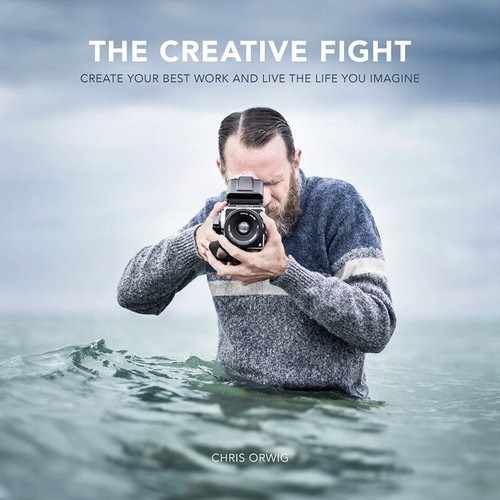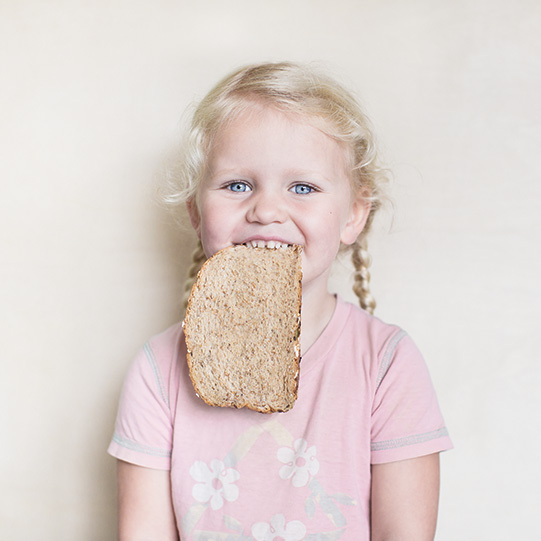Chapter Five. Creativity and Sliced Bread

Creativity isn’t something that stands on its own. It’s part of a larger process that involves at least these four parts: 1. Information 2. Imagination 3. Creativity 4. Innovation. These steps are connected like four corners on a single piece of sliced bread.
The first corner is information. Information is where it all begins. It is knowledge, data, input, and ideas. Information is raw like a piece of unfinished wood or a straightforward fact. Without information we have nowhere to go.
The second corner is imagination. Imagination is the ability to call to mind something that doesn’t yet exist or that isn’t present right now. You can imagine a unicorn flying across the sky or the look of surprise on your sister’s face when she opens her gift. Imagination is wild, free, and fun. Imagination is naive and it doesn’t like to conform. Imagination is made up of ideals, but it doesn’t mind breaking the rules. Imagination feels empathy for a stranger. Imagination can be twisted or weird. Imagination is up in the clouds and under the sea. Imagination has no boundaries at all. As Einstein said, “Imagination encircles the world.” And you don’t have to be Einstein to know that imagination is more important than knowledge. Imagination is where knowledge is let out of the cage.
The third corner is creativity. Creativity is where imagination gets to work. Creativity requires that we roll up our sleeves. John Lennon imagined world peace, yet it was an act of creativity to write and perform the song. Creativity is where we get things done. To create is to make. We all do that, no matter our jobs. Yet the creative flow can dwindle or thrive. And creativity always has a forward positive lean. Creativity likes to ask questions and look for ways to add value to life. It isn’t elitist, arrogant, or proud. Creativity is down to earth and real. It likes to have fun but also works hard.
Creativity has many friends, like curiosity, craftsmanship, and contribution. One of creativity’s closest friends is art. Creativity is similar to art but at the same time distinct—like fraternal twins who were born on the same day but with distinctive genetic strands. All art is creative but not all creativity is art. Sometimes creativity creates beauty or value, but other times it falls short. Yet creativity always aims for good.
At its core, creativity is about taking the ordinary and making it more. It’s about making the best with the situation and materials at hand. It’s about seeing what has been seen but doing so with a new lens. Creativity helps us thrive. It makes us better parents, citizens, and friends. Creativity is contagious. Become creative in one area of your life and it will help the other areas as well. Most importantly, creativity requires exertion, power, and force. The creative juices rarely flow while you passively watch. Creativity beckons us to leave our spectator’s mind-set, to start and to get something done.
The fourth corner is innovation. Innovation is born when creativity produces something of value that affects more than one. Innovation is a new idea, device, or process. It is the application of creativity in a particular way. Art is innovative. Art is creativity that has reached a higher goal. There are innovations that improve global communications or the way we make shoes. There is art that has changed the world. Innovations include things like antibiotics, fiber optics, or biofuels. The airplane, Internet, and phone are innovations too. Innovations always rely on creative work. Yet some of the biggest innovations came about as the result of the pursuit of something else. Innovation almost always comes as a celebratory surprise. And new innovations lead to new knowledge, information, and ideas, just as the best art self-propagates, gives birth to new ideas, expands the imagination, and makes others want to create their own art. In this way, the four corners are inseparable and baked together in this little slice of bread.
The four corners are clearly distinct, yet not one of them can stand alone. Remove one corner and you will tear into another element as well. The magic is in the interdependent combination of the whole. So while we’ll pursue creativity in this book, it’s critical to keep this larger picture in mind. Creativity isn’t self-contained. And it isn’t just about imagination or fun; it’s also about information and innovation.
The Creative Process in Action
Let’s take a quick look at how this process works in more concrete terms.
Information is seeing a picture of a treehouse online. There it is. This is the beginning of an idea. Whether or not the idea will survive depends on the next step.
Imagination is conjuring up an image of what a treehouse might look like in your backyard. Imagination is remembering the treehouse you wished you had. Imagination is letting your mind wander to think about how much fun your kids would have. Imagination gets carried away and starts to dream up a treehouse that will cost $15k to build.
Like the proverbial voice of wisdom, information reminds imagination that the cost is too high. Information likes to stop imagination from getting out of control. Sometimes imagination will comply, and other times it will rebel. Imagination bounces around like a Super Ball thrown indoors. Imagination is unpredictable and fun. But it likes to change shape. No longer a bouncing ball, imagination turns into a flood.
A TREE HOUSE, A FREE HOUSE, A SECRET YOU AND ME HOUSE, A HIGH UP IN THE LEAFY BRANCHES COZY AS CAN BE HOUSE. A STREET HOUSE, A NEAT HOUSE, BE SURE TO WIPE YOUR FEET HOUSE IS NOT MY KIND OF HOUSE AT ALL—LET’S GO LIVE IN A TREE HOUSE.
— SHEL SILVERSTEIN
The combined force of information and imagination is a current that can sweep you away or get you to act. Sometimes imagination can provoke you to search endlessly for new ideas.
Creativity calls you to fight the tide and to gather your ideas onto one Pinterest board. This creative act fuels and focuses your imagination even more. Next comes the creative step of sketching a treehouse idea during a dull meeting at work. Then you decide to stop by the lumberyard to think about supplies. With each stride, your creative muscles become stronger. Still, imagination tempts you to stop. You have to fight off imagination’s pull if you’re actually going to build.
The moment the first nail secures wood to the tree, the creative fight begins to win. No longer the domain of dreams, the treehouse is becoming real. With tenacity and drive, the odds for the project’s success increase.
During the construction phase, if the treehouse builder discovers a new building technique and posts online to rave reviews, innovation has been achieved. If the treehouse is so well designed that it’s referred to as a work of art, then maybe it is. When the treehouse is complete, it stands as a testament to the creative fight and it becomes a gift to the kids and to the neighbors who now want to build one themselves. This treehouse story isn’t just a fictional tale. This is my story (minus the part about being a work of art). We now have two treehouses in our backyard, and they inspired three other tree forts that have since been built by neighborhood friends.
STEP 1
In order to identify the flow of the creative process, reflect back on something you accomplished and write out what was involved in each step. If you didn’t achieve the final step, that’s OK. When it comes to adding value in an innovative way, write out what you strove for. Creativity always reaches for good.
Information________________________________________________________________
Imagination________________________________________________________________
Creativity__________________________________________________________________
Innovation_________________________________________________________________
STEP 2
Creative accomplishment rarely happens on its own. Creating a roadmap can help. Write out a creative project you want to achieve and the steps needed to get there.
Creative Project____________________________________________________________
Information________________________________________________________________
Imagination________________________________________________________________
Creativity__________________________________________________________________
Innovation_________________________________________________________________
STEP 3
Take a moment to let your imagination roam free. If you had the chance to become a better artist, what field would you pursue? On a scratch sheet of paper, write down a few ideas.

